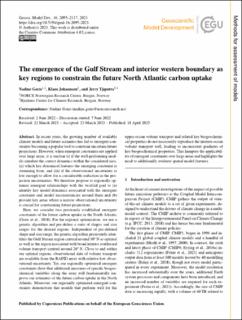| dc.contributor.author | Goris, Nadine | |
| dc.contributor.author | Johannsen, Klaus | |
| dc.contributor.author | Tjiputra, Jerry | |
| dc.date.accessioned | 2023-09-20T09:13:51Z | |
| dc.date.available | 2023-09-20T09:13:51Z | |
| dc.date.created | 2023-04-18T12:50:41Z | |
| dc.date.issued | 2023 | |
| dc.identifier.citation | Geoscientific Model Development. 2023, 16 (8), 2095-2117. | en_US |
| dc.identifier.issn | 1991-959X | |
| dc.identifier.uri | https://hdl.handle.net/11250/3090738 | |
| dc.description.abstract | In recent years, the growing number of available climate models and future scenarios has led to emergent constraints becoming a popular tool to constrain uncertain future projections. However, when emergent constraints are applied over large areas, it is unclear (i) if the well-performing models simulate the correct dynamics within the considered area, (ii) which key dynamical features the emerging constraint is stemming from, and (iii) if the observational uncertainty is low enough to allow for a considerable reduction in the projection uncertainties. We therefore propose to regionally optimize emergent relationships with the twofold goal to (a) identify key model dynamics associated with the emergent constraint and model inconsistencies around them and (b) provide key areas where a narrow observational uncertainty is crucial for constraining future projections. Here, we consider two previously established emergent constraints of the future carbon uptake in the North Atlantic (Goris et al., 2018). For the regional optimization, we use a genetic algorithm and pre-define a suite of shapes and size ranges for the desired regions. Independent of pre-defined shape and size range, the genetic algorithm persistently identifies the Gulf Stream region centred around 30∘ N as optimal as well as the region associated with broad interior southward volume transport centred around 26∘ N. Close to and within our optimal regions, observational data of volume transport are available from the RAPID array with relative low observational uncertainty. Yet, our regionally optimized emergent constraints show that additional measures of specific biogeochemical variables along the array will fundamentally improve our estimates of the future carbon uptake in the North Atlantic. Moreover, our regionally optimized emergent constraints demonstrate that models that perform well for the upper-ocean volume transport and related key biogeochemical properties do not necessarily reproduce the interior-ocean volume transport well, leading to inconsistent gradients of key biogeochemical properties. This hampers the applicability of emergent constraints over large areas and highlights the need to additionally evaluate spatial model features. | en_US |
| dc.language.iso | eng | en_US |
| dc.rights | Navngivelse 4.0 Internasjonal | * |
| dc.rights.uri | http://creativecommons.org/licenses/by/4.0/deed.no | * |
| dc.title | The emergence of the Gulf Stream and interior western boundary as key regions to constrain the future North Atlantic carbon uptake | en_US |
| dc.title.alternative | The emergence of the Gulf Stream and interior western boundary as key regions to constrain the future North Atlantic carbon uptake | en_US |
| dc.type | Journal article | en_US |
| dc.type | Peer reviewed | en_US |
| dc.rights.holder | © Author(s) 2023 | en_US |
| dc.description.version | publishedVersion | en_US |
| cristin.ispublished | true | |
| cristin.fulltext | original | |
| cristin.qualitycode | 2 | |
| dc.identifier.doi | 10.5194/gmd-16-2095-2023 | |
| dc.identifier.cristin | 2141581 | |
| dc.source.journal | Geoscientific Model Development | en_US |
| dc.source.volume | 16 | en_US |
| dc.source.issue | 8 | en_US |
| dc.source.pagenumber | 2095-2117 | en_US |

